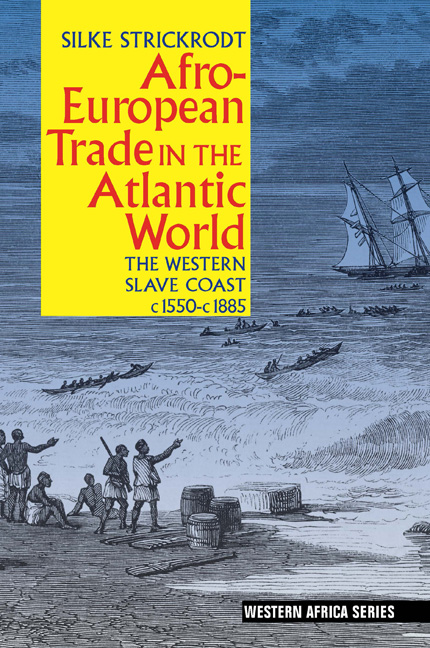Book contents
- Frontmatter
- Dedication
- Contents
- List of Maps
- List of Abbreviations
- Acknowledgements
- Map
- Introduction
- 1 The regional setting
- 2 The Atlantic connection: Little Popo & the rise of Afro-European trade, c.1600 to 1702
- 3 The era of the warrior kings: 1702 to 1772
- 4 The era of the traders: 1772 to c.1807
- 5 Disintegration & reconstitution: Political developments, 1820s to 1870s
- 6 From slaves to palm oil: Afro-European trade, c.1807 to 1870s
- Epilogue: The colonial partition & its consequences, 1870s to c.1900
- Bibliography
- Index
1 - The regional setting
Published online by Cambridge University Press: 05 May 2015
- Frontmatter
- Dedication
- Contents
- List of Maps
- List of Abbreviations
- Acknowledgements
- Map
- Introduction
- 1 The regional setting
- 2 The Atlantic connection: Little Popo & the rise of Afro-European trade, c.1600 to 1702
- 3 The era of the warrior kings: 1702 to 1772
- 4 The era of the traders: 1772 to c.1807
- 5 Disintegration & reconstitution: Political developments, 1820s to 1870s
- 6 From slaves to palm oil: Afro-European trade, c.1807 to 1870s
- Epilogue: The colonial partition & its consequences, 1870s to c.1900
- Bibliography
- Index
Summary
The western Slave Coast can be regarded as a sub-region of the Slave Coast, the latter being conventionally defined as comprising the coastal area between the Volta river in the west and the Lagos channel in the east. The term ‘Slave Coast’ was being used by the seventeenth century. The Slave Coast was mainly defined externally, in terms of the European activities affecting it, as a source of enslaved Africans for shipment to the Americas. It has been argued, however, that there were also internal characteristics that justified its treatment as a unit. In terms of physical geography, two features stand out: the Benin (or Dahomey) Gap, a stretch of savannah (rather than tropical forest) which affected the microclimate, and a system of lagoons which extended along almost the whole of the coast, connecting the various places and serving as an integrating factor. Also, there was a degree of cultural and linguistic unity, as the Slave Coast was settled mainly by Gbe-speaking peoples who trace their origins to Tado, with the exception of the Yoruba in the extreme east and northeast.
The western Slave Coast was an integral part of the Slave Coast, sharing all the characteristics mentioned above. There were also however features that set it apart, justifying its treatment as a distinct entity. First, while the eastern part of the Slave Coast enjoyed easy communication with the far interior due to the relative openness of the country, putting it at the mercy of Oyo's invasions in the late seventeenth and eighteenth centuries but also enabling the establishment of trade connections that were crucial for regular and abundant supplies of enslaved Africans for the trade with Europeans, the importance of the hinterland of the western Slave Coast was limited by the Togo-Atacora mountain ranges, restricting communication and exchange with the far interior. Second (and perhaps linked with the first point), unlike the eastern Slave Coast, which from the 1720s was controlled by the kingdom of Dahomey, there was no single large state that dominated the western Slave Coast.
- Type
- Chapter
- Information
- Afro-European Trade in the Atlantic WorldThe Western Slave Coast, c. 1550–c.1885, pp. 28 - 64Publisher: Boydell & BrewerPrint publication year: 2015



